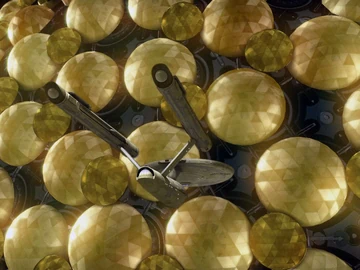The Fesarius was a starship built and operated by the First Federation, encountered in the mid-23rd century. It was described as the flagship by its captain and only crewmember, Commander Balok.
The Fesarius initiated first contact between the Federation and the First Federation in 2266, when it was encountered by the Federation starship USS Enterprise. (TOS: "The Corbomite Maneuver")
Technical details and capabilities[]

The Fesarius and the Enterprise at 5000 meters
The Fesarius was very large and spherical, with the surface made up of smaller, dome-like features, arranged in a distinct pattern based on triangles. The ship was able to dispatch at least one small craft, described as a "pilot vessel", and could be controlled by just one crewman using a very simple-looking interface.
The mass of the Fesarius was beyond the ability of 23rd century Starfleet instruments to register. Commander Spock estimated the vessel to be "a mile in diameter." However, the screen shots showing both ships indicate that the Fesarius clearly is much larger than Spock's estimate, because one mile would be approximately 5.5 times as long as the 947-foot Enterprise. Even at a distance of 5,000 meters, the Fesarius still filled the entirety of the Enterprise viewscreen at normal magnification.
The vessel was able to scan the entirety of the USS Enterprise in a few seconds, in sufficient detail to then override and shut down some of its systems, a level of control that was described as "extremely sophisticated" and "brilliant." (TOS: "The Corbomite Maneuver")
Appendices[]
Background information[]
In the final draft script of "The Corbomite Maneuver" (dated 3 May 1966), the Fesarius was described thus; "No appraisal is possible, for this object […] is completely alien in appearance. It is in the shape of a round cluster of grapes (or fish eggs or lead shot or a honeycomb), but it looks very functional [....] Some of its cell-like sections pulse with an inner light." In the second revised draft of the script (dated 20 May 1966), this description was simplified, with the Fesarius said to be "in the shape of a round cluster of balls." Also, the ship wasn't referred to as seeming "very functional", and the words "some of" were omitted. Both scripts characterized the vessel as a "colossus" that dwarfed the Enterprise. The final draft elaborated that the Fesarius' "cell-like sections" were to be "vari-colored" and the same script further stated, "Not only is it formidable in size, but it is also visually impressive, looking all-powerful and frighteningly superior."
Neither the Fesarius nor any other vessel of the First Federation has been seen since "The Corbomite Maneuver".
Based on Star Trek: Star Charts (p. 36), and the Stellar Cartography: The Starfleet Reference Library ("Stellar Cartography", p. 10; "Federation Historical Highlights, 2161-2385"), one possible origin for the name of the ship was the Fesarius system. This was the capital system of the First Federation. The primary was a K-class star. This system was located in the Alpha Quadrant.
Studio models[]

|

|

| |
The Fesarius miniature was designed by Matt Jefferies. (Star Trek Encyclopedia, 4th ed., vol. 1, p. 269) The construction of the model has been attributed to Wah Chang, as per Desilu's purchase orders to him – currently archived at the UCLA. [1] According to Star Trek History, the model was a big ball endowed with "a pair of dimmers to make the model ship pulsate with power. The model was covered with sliced ping-pong balls."
However, the visual effects involved in depicting the Fesarius kept "The Corbomite Maneuver" from airing as the first episode of Star Trek. Jerry Sohl, the writer of "The Corbomite Maneuver", explained, "They were having such a difficult time with the special effects for the starship Fesarius… such an enormous ship… and this held them up for so long that it became the tenth episode to be shown." (The Star Trek Interview Book, p. 128) The effects sequences were filmed at the Howard Anderson Company in the period 3 June 1966 through 31 October of that year, coming eventually in at US$17,317 – or 10% of the total budget and US$4,000 above the allowance for the effects. (These Are the Voyages: TOS Season One, 1st ed, pp. 126-127) The delays the company experienced during the production of these effects necessitated Associate Producer Robert H. Justman and Post-Production Supervisor Edward K. Milkis to hire virtually every other Hollywood effects house in existence at the time in order to alleviate the pressure on Anderson and to keep production of the Original Series on its tight schedules. (Inside Star Trek: The Real Story, 1997, p. 262)
When it came time to construct the Fesarius as a CGI model in 2006 for the remastered counterpart of the episode, the visual effects artists at CBS Digital tried to stay as close to the original as they could while also adding a level of detail that VFX Line Producer Michael Okuda stated "probably should have been there at the beginning," thus showing, though not overtly, an internal infrastructure beneath each of the ship's many domes. ("Spacelift: Transporting Trek into the 21st Century", TOS Season 1 Blu-ray special features)
Apocrypha[]
According to Star Trek Maps (Chart B and D), the Fesarius was a patrol ship in the largely uninhabited frontier of the First Federation. The ship was an automated craft designed to respond and intercept at multi-warp speeds any hostile force encountered by the defense outpost buoy network. The Fesarius was possibly named after the homeworld Fesarius and its namesake primary and star system.
In the William Shatner novel Dark Victory, this is a class of ship which is destroyed to prevent them from being captured by the mirror universe Kirk.
Further Reading[]
- Star Trek: The Official Starships Collection, issue 146, 2019
External links[]
- Fesarius at Memory Beta, the wiki for licensed Star Trek works
